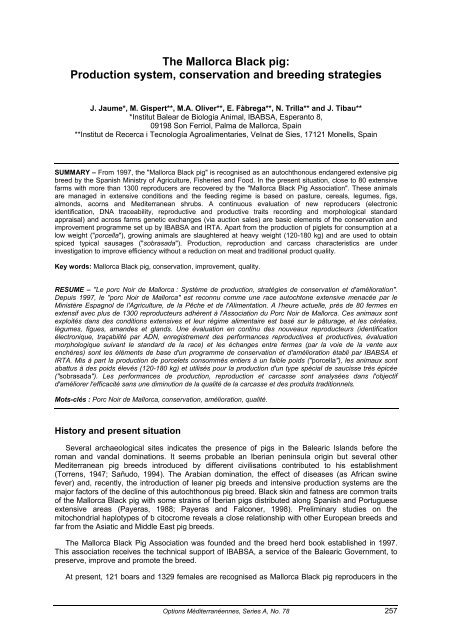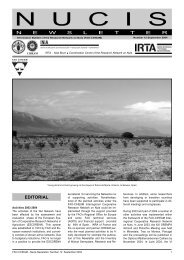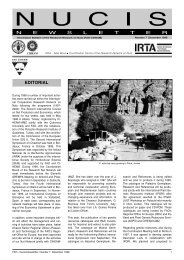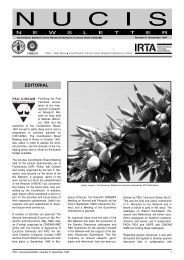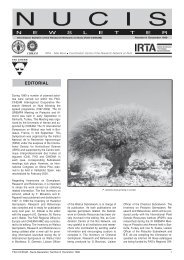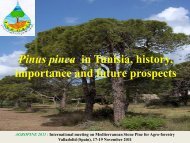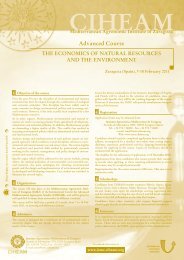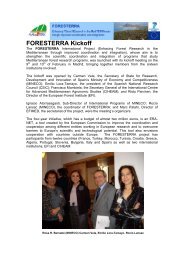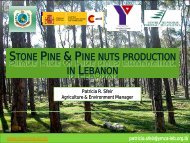THE MAJORCAN BLACK PIG : - IAMZ
THE MAJORCAN BLACK PIG : - IAMZ
THE MAJORCAN BLACK PIG : - IAMZ
You also want an ePaper? Increase the reach of your titles
YUMPU automatically turns print PDFs into web optimized ePapers that Google loves.
The Mallorca Black pig:<br />
Production system, conservation and breeding strategies<br />
J. Jaume*, M. Gispert**, M.A. Oliver**, E. Fàbrega**, N. Trilla** and J. Tibau**<br />
*Institut Balear de Biologia Animal, IBABSA, Esperanto 8,<br />
09198 Son Ferriol, Palma de Mallorca, Spain<br />
**Institut de Recerca i Tecnología Agroalimentaries, Veïnat de Sies, 17121 Monells, Spain<br />
SUMMARY – From 1997, the "Mallorca Black pig" is recognised as an autochthonous endangered extensive pig<br />
breed by the Spanish Ministry of Agriculture, Fisheries and Food. In the present situation, close to 80 extensive<br />
farms with more than 1300 reproducers are recovered by the "Mallorca Black Pig Association". These animals<br />
are managed in extensive conditions and the feeding regime is based on pasture, cereals, legumes, figs,<br />
almonds, acorns and Mediterranean shrubs. A continuous evaluation of new reproducers (electronic<br />
identification, DNA traceability, reproductive and productive traits recording and morphological standard<br />
appraisal) and across farms genetic exchanges (via auction sales) are basic elements of the conservation and<br />
improvement programme set up by IBABSA and IRTA. Apart from the production of piglets for consumption at a<br />
low weight ("porcella"), growing animals are slaughtered at heavy weight (120-180 kg) and are used to obtain<br />
spiced typical sausages ("sobrasada"). Production, reproduction and carcass characteristics are under<br />
investigation to improve efficiency without a reduction on meat and traditional product quality.<br />
Key words: Mallorca Black pig, conservation, improvement, quality.<br />
RESUME – "Le porc Noir de Mallorca : Système de production, stratégies de conservation et d'amélioration".<br />
Depuis 1997, le "porc Noir de Mallorca" est reconnu comme une race autochtone extensive menacée par le<br />
Ministère Espagnol de l'Agriculture, de la Pêche et de l'Alimentation. A l'heure actuelle, près de 80 fermes en<br />
extensif avec plus de 1300 reproducteurs adhèrent à l'Association du Porc Noir de Mallorca. Ces animaux sont<br />
exploités dans des conditions extensives et leur régime alimentaire est basé sur le pâturage, et les céréales,<br />
légumes, figues, amandes et glands. Une évaluation en continu des nouveaux reproducteurs (identification<br />
électronique, traçabilité par ADN, enregistrement des performances reproductives et productives, évaluation<br />
morphologique suivant le standard de la race) et les échanges entre fermes (par la voie de la vente aux<br />
enchères) sont les éléments de base d'un programme de conservation et d'amélioration établi par IBABSA et<br />
IRTA. Mis à part la production de porcelets consommés entiers à un faible poids ("porcella"), les animaux sont<br />
abattus à des poids élevés (120-180 kg) et utilisés pour la production d'un type spécial de saucisse très épicée<br />
("sobrasada"). Les performances de production, reproduction et carcasse sont analysées dans l'objectif<br />
d'améliorer l'efficacité sans une diminution de la qualité de la carcasse et des produits traditionnels.<br />
Mots-clés : Porc Noir de Mallorca, conservation, amélioration, qualité.<br />
History and present situation<br />
Several archaeological sites indicates the presence of pigs in the Balearic Islands before the<br />
roman and vandal dominations. It seems probable an Iberian peninsula origin but several other<br />
Mediterranean pig breeds introduced by different civilisations contributed to his establishment<br />
(Torrens, 1947; Sañudo, 1994). The Arabian domination, the effect of diseases (as African swine<br />
fever) and, recently, the introduction of leaner pig breeds and intensive production systems are the<br />
major factors of the decline of this autochthonous pig breed. Black skin and fatness are common traits<br />
of the Mallorca Black pig with some strains of Iberian pigs distributed along Spanish and Portuguese<br />
extensive areas (Payeras, 1988; Payeras and Falconer, 1998). Preliminary studies on the<br />
mitochondrial haplotypes of b citocrome reveals a close relationship with other European breeds and<br />
far from the Asiatic and Middle East pig breeds.<br />
The Mallorca Black Pig Association was founded and the breed herd book established in 1997.<br />
This association receives the technical support of IBABSA, a service of the Balearic Government, to<br />
preserve, improve and promote the breed.<br />
At present, 121 boars and 1329 females are recognised as Mallorca Black pig reproducers in the<br />
Options Méditerranéennes, Series A, No. 78 257
herd book. The population is fragmented in small herds (79) with an average of 20 reproducers each<br />
(Table 1), sex ratio (males/females) in nucleus herds is close to 10% and only a reduced number of<br />
farms distributes male reproducers to other herds. Consequently the efective genetic population is<br />
lower than real figures.<br />
Table 1. Statistics of Mallorca Black Pig Herd book<br />
Year Total reproducers Sows Boars Farms<br />
1998 447 409 38 30<br />
2000 730 656 74 50<br />
2002 908 817 91 85<br />
2004 1102 989 113 91<br />
2005 1440 1329 121 79<br />
Production system<br />
The Mallorca Black pig is managed in extensive conditions (25 pigs/hectare) as a complementary<br />
agricultural activity in family farms (Fig. 1). Because of the extensive production system, males and<br />
females remains together and matings are difficult to be controlled. In some cases the paternity of<br />
young piglets is uncertain and free piglet adoptions is not uncommon between sows (Jaume, 2000).<br />
Fig. 1. Extensive production conditions.<br />
Feeding regime is based on pasture, cereals (barley and rye), legume seeds, figs, almonds,<br />
acorns, and several Mediterranean shrubs. Aside of natural feeding resources sows are feed with<br />
commercial diets during lactation and pregnancy. Additionally growing pigs to slaughter are<br />
supplemented with barley and green peas.<br />
Reproduction figures are similar to other extensive breeds (Dobao et al., 1988). The litters per<br />
sows per year is close to 2 and the average number of piglets weaned per sow and year is nearly 12<br />
(Table 2). A large variability is observed in reproductive traits and the management conditions have a<br />
large influence in this parameters. Lactation period is usually over 4 weeks and in some cases young<br />
piglets (close to 8 kg live weight) are removed and consumed as "porcelles".<br />
258<br />
Options Méditerranéennes, Series A, No. 78
Table 2. Reproduction traits in Majorcan Black pigs<br />
Piglets/litter Average SD<br />
Total born 7.9 2.62<br />
Born alive 7.5 2.45<br />
Alive at 1 week 6.1 2.35<br />
Piglets weaned 6.0 2.35<br />
Traditional growing period is longer than 12 months and the minimum live weight accepted to produce<br />
"sobrasada" is 120 kg. Males to be slaughtered are castrated at a young age. Average daily gain, despite<br />
of the extensive conditions of production, is close to 600 g/day from 25 to 65 kg live weight (Table 3).<br />
Table 3. Average daily gain (g/day) in different test periods for females and males<br />
retained in the Mallorca Black Pig Association (November 2005 Auction Sale)<br />
Sex Period 1 Period 2<br />
Female Weights (kg) 14-24 24-59<br />
ADG (g/d) 392(40) † 598(80) †<br />
Males Weights (kg) 17-28 28-64<br />
ADG (g/d) 417(49) † 627(70) †<br />
† Standard deviations in brackets.<br />
Morphological traits<br />
Main characteristics of this breed are in accordance with other western Mediterranean pig breeds:<br />
black colour (or slate-grey) and high percentage of fat tissue (as most strains of Iberian pigs). The<br />
traditional morphological characteristics established in the herd book of the Mallorca Back Pig are: (i) slategrey<br />
skin colour; (ii) concave nose profile; (iii) tassels in the neck base; and (iv) large and pendulous ears.<br />
Size of adult animals is moderate (150 kg) and the average number of functional teats is 10.61.<br />
Animals with white spots, leg weakness, non horizontal back profile, less than 10 functional teats or<br />
conformed hams are not inscribed in the herd book in order to maintain basic morpho-functional<br />
standards (Figs 2 and 3).<br />
Fig. 2. Mallorca Black pig boar.<br />
Options Méditerranéennes, Series A, No. 78 259
Fig. 3. Mallorca Black pig female.<br />
Conservation program and breeding strategies<br />
In the present situation all animals are identified with tattoo and electronic ear tags and an specific<br />
information system, including full reproduction data of the nucleus herds, are managed by IBABSA to<br />
provide advice to the Mallorca Black Pig Association. Biological samples are obtained from new<br />
reproducers, included in the herd book and tested, in order to estimate the genetic variability using<br />
DNA analysis. Twelve microsatellites located in 11 different chromosomes, previously described in<br />
literature, are currently analyzed to verify the parentage and identification of individual animals in<br />
these porcine populations.<br />
Conservation programme is based on a limitation of the number of young females retained per<br />
sow and boar and with a continuous exchange of genetic material across herds in order to avoid an<br />
increase of inbreeding rates.<br />
In the last year (2005) 439 new sows from 121 different boars and 230 sows contributed to replace<br />
the 1329 adult sows in all herds. Replacement rate is 33%. No more than 2 young sows from the<br />
same mother are accepted in the herd book per year and an average of 3.6 young sows per boar are<br />
used yearly to replace culled ones. In the present situation all boars contributed to the replacement<br />
with at least one young sow.<br />
Table 4. Conservation program statistics in 2005 year<br />
New sows culled per boar Number of boars Total number of culled new sows Culling rate<br />
1-2 31 46 10.5<br />
3-5 64 134 30.5<br />
6-10 17 119 27.0<br />
11-23 9 140 32.0<br />
Total 121 439<br />
Carcass and meat charateristics<br />
Aside of the consumption of roasted piglets with an average carcass weight of 8 kg "porcella"<br />
(mainly in winter time), most of the traditional high quality products in the Balearic Islands are based<br />
on Mallorca Black pig ("sobrasada", "botifarrons").<br />
260<br />
Options Méditerranéennes, Series A, No. 78
The most important product is "sobrasada" (Fig. 4) a type of highly seasoned sausage with<br />
paprika, pepper and salt with a texture similar to "batter". All cuts of the carcasses are used to<br />
produce "sobrasada" but flare fat ("saim") could be used in the confectionery of special sweet cakes<br />
("ensaimada").<br />
Fig. 4. "Sobrasada".<br />
Main cuts as loin, terderloin, shoulder and ham are less than 30% of he hot carcass weight (Fig. 5)<br />
and fat represents more than 46% of the carcass carried about with all the main cuts, additional ones<br />
(as double chin, abdominal and back, kidneys, liver, lung) and blood are used to produce<br />
"sobrasada". Preliminary results of intramuscular fat content in the loin ranges from 5 to 10%, like in<br />
Iberian pigs, and an specific use of this cut to produce dry cured loin will be investigated. Several<br />
meat characteristics (pH, water holding capacity, color and fatty acids composition) and sensory traits<br />
will be analyzed at the IRTA Meat Technology Center.<br />
Blood<br />
1.0%<br />
Lung and heart<br />
1.1%<br />
Liver<br />
1.8%<br />
Intestinal fat<br />
2.0%<br />
Head<br />
4.4%<br />
Double chin<br />
4.4% Abdominal fat<br />
4.8% Ribs<br />
4.8%<br />
Back bone<br />
3.4%<br />
Hands<br />
0.8%<br />
Fat<br />
43.4%<br />
Kidney<br />
0.2%<br />
Tenderloin<br />
0.5%<br />
Loin<br />
4.9%<br />
Ham<br />
12.9%<br />
Shoulder<br />
9.5%<br />
Head Double chin Abdominal fat Ribs<br />
Back bone Hands Shoulder Ham<br />
Loin Tenderloin Kidney Fat<br />
Blood Liver Lung and Heart Intestinal fat<br />
Fig. 5. Distribution of the carcass cuts in Mallorca Black pigs.<br />
Options Méditerranéennes, Series A, No. 78 261
References<br />
Dobao, M.T., Rodrigáñez, L., Silió, L. and Toro, M.A. (1988). Iberian pig production in Spain. Pig<br />
News and Information, 9(3): 277-282.<br />
Jaume, J. (2000). El Cerdo Negro Mallorquín. In: Porcino Ibérico. Aspectos Claves. Mundi Prensa,<br />
Madrid.<br />
Payeras, Ll. (1988). El Porc Mallorquí. In: Els Animals Domèstics de Raça Autòctona de Mallorca.<br />
PRAM, Palma de Mallorca, Spain.<br />
Payeras, Ll. and Falconer, J. (1998). Races autóctones de les Illes Balears. Govern Balear.<br />
Sañudo, C. (1994). Las razas autóctonas tradicionales. Mundo Ganadero, 3.<br />
Torrens, A. (1947). El cerdo negro mallorquín. In: Primer Congreso Internacional de Zootecnia.<br />
262<br />
Options Méditerranéennes, Series A, No. 78


